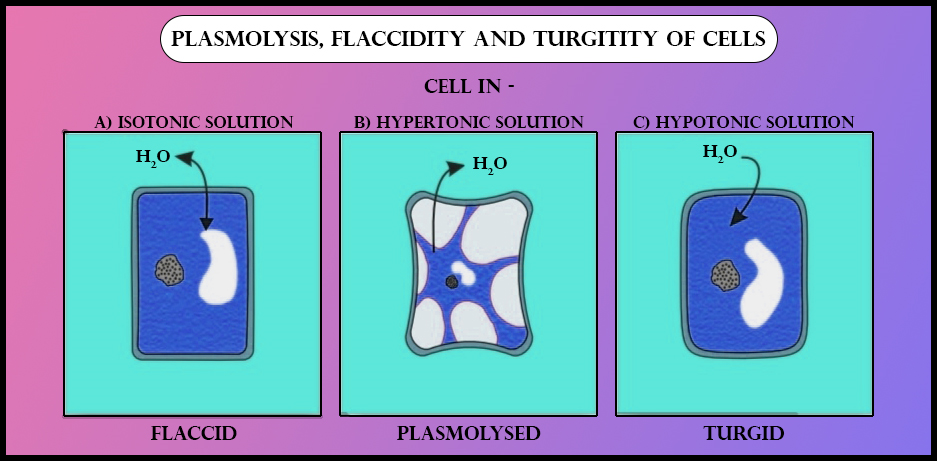
Turgor pressure of the plasmolyzed cell is
(a) Positive
(b) Zero
(c) Negative
(d) None of the above
Answer
562.2k+ views
Hint: The pressure against the cell wall due to the fluid is called turgor pressure, in a plasmolyzed cell plasma membrane shrinks from the cell wall.
Complete answer:
> When the water moves out of the cell, the cell and cell membrane of the plant shrinks away from the cell wall resulting in plasmolysis. This process is usually reversible. When a cell is placed in a hypotonic solution the water from the surrounding enters into the cell resulting in pressure buildup against the cell wall.

> This pressure is called turgor pressure. In a cell placed in the hypertonic solution the cell membrane shrinks and no pressure buildup against the cell wall. So the turgor pressure is zero.
Additional information:
- When the water is drawn out of the cell through diffusion into the extracellular fluid causes the protoplast to shrink away from the cell wall. If the plasma membrane shrinks away only from the cell wall corners, it is called incipient plasmolysis. If this cell is placed in a hypertonic solution for a long time, then the cell becomes completely plasmolyzed.
- In a completely plasmolyzed cell, the solute potential is equal to the water potential and the pressure against the cell wall is zero.
- This pressure against the cell wall is called turgor pressure.
So, the correct answer is ‘(b) Zero’
Note:
> Some of the applications of plasmolysis are, it is used in the salting of meat, fish, and pickles. When they are plasmolyzed, water content inside the cell will be very low so the chances of attacking pathogens like bacteria are low.
> In a cell placed in a hypotonic solution, turgor pressure is positive.
Complete answer:
> When the water moves out of the cell, the cell and cell membrane of the plant shrinks away from the cell wall resulting in plasmolysis. This process is usually reversible. When a cell is placed in a hypotonic solution the water from the surrounding enters into the cell resulting in pressure buildup against the cell wall.

> This pressure is called turgor pressure. In a cell placed in the hypertonic solution the cell membrane shrinks and no pressure buildup against the cell wall. So the turgor pressure is zero.
Additional information:
- When the water is drawn out of the cell through diffusion into the extracellular fluid causes the protoplast to shrink away from the cell wall. If the plasma membrane shrinks away only from the cell wall corners, it is called incipient plasmolysis. If this cell is placed in a hypertonic solution for a long time, then the cell becomes completely plasmolyzed.
- In a completely plasmolyzed cell, the solute potential is equal to the water potential and the pressure against the cell wall is zero.
- This pressure against the cell wall is called turgor pressure.
So, the correct answer is ‘(b) Zero’
Note:
> Some of the applications of plasmolysis are, it is used in the salting of meat, fish, and pickles. When they are plasmolyzed, water content inside the cell will be very low so the chances of attacking pathogens like bacteria are low.
> In a cell placed in a hypotonic solution, turgor pressure is positive.
Recently Updated Pages
The number of solutions in x in 02pi for which sqrt class 12 maths CBSE

Write any two methods of preparation of phenol Give class 12 chemistry CBSE

Differentiate between action potential and resting class 12 biology CBSE

Two plane mirrors arranged at right angles to each class 12 physics CBSE

Which of the following molecules is are chiral A I class 12 chemistry CBSE

Name different types of neurons and give one function class 12 biology CBSE

Trending doubts
One Metric ton is equal to kg A 10000 B 1000 C 100 class 11 physics CBSE

Explain zero factorial class 11 maths CBSE

What is 1s 2s 2p 3s 3p class 11 chemistry CBSE

Discuss the various forms of bacteria class 11 biology CBSE

State the laws of reflection of light

An example of chemosynthetic bacteria is A E coli B class 11 biology CBSE




